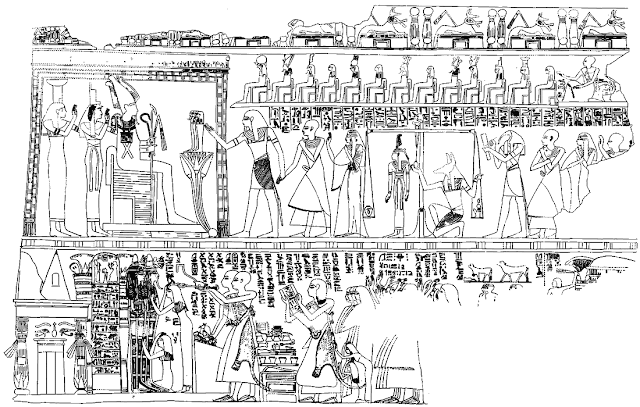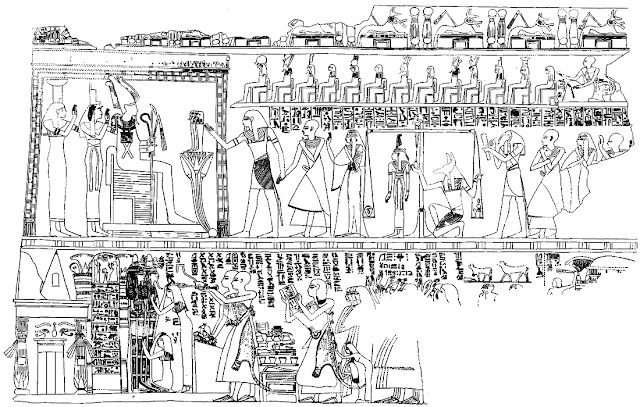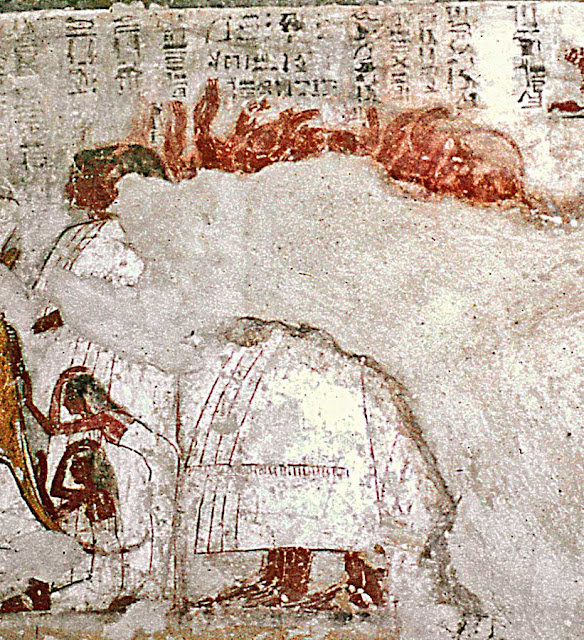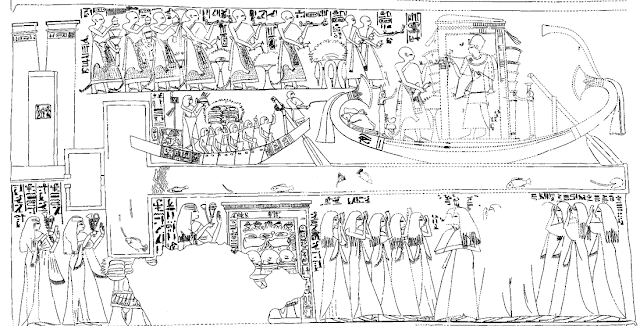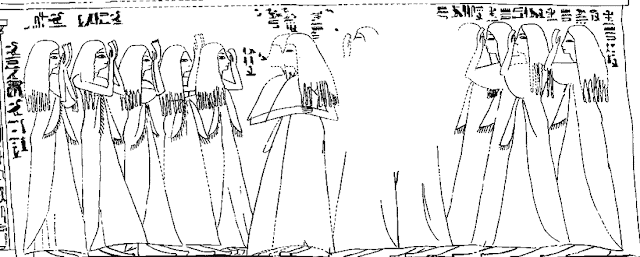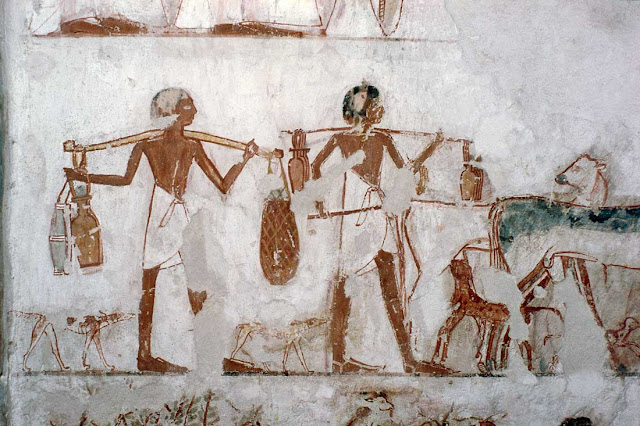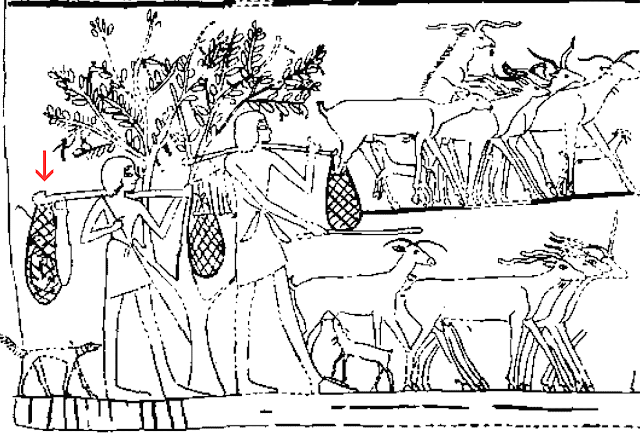THE LONGITUDINAL CHAMBER
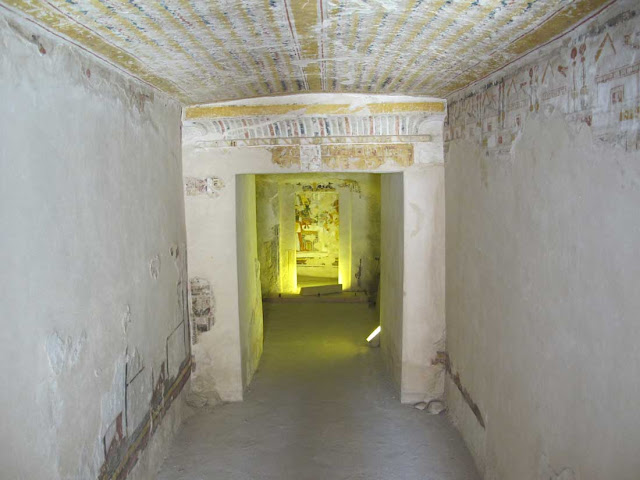
This chamber is approximately 3.8m in length, 1.6m wide at the entry (east) end and 1.7m wide at the west end. The height at entry end it is approximately 1.7m and 2.0m at west end. It has a slightly upcurved ceiling.

The ceiling
In contrast with the now almost naked walls, this is preserved entirely It is slightly arched and divided into two rectangular areas by a central yellow band and also surrounded, at the edges, by two bands, one south and one north, extending to where they join the central band at the two doorways. All the bands have black texts

towards the entrance, thus the texts all start at the east end.
Text 1 (south side): "An invocatory offering to Osiris-Khentymentiu, the great god, lord of the Sacred Land; (to) Ptah-Sokar in the secret shrine; (to) Resh-Wedja in front of Rostaw (the nickname of Osiris: the awakened unscathed, Wörterbuch 2, p.451, note 13); (to) Anubis, in front of the divine pavilion; to Nefertum; (to) Horus-Hekenu, the great god on his [... ...], so that they grant the view of all secrets of the underworld, the entry and the exit of the necropolis, and that his soul be not repulsed at any of the gates of the underworld. For the Ka of the one who is greatly praised by the Lords of eternity, the high-priest of Menkheperre, Khonsu, justified, possessor of favour, happily in peace".

Text 2 (north side): "An invocatory offering to Amon-Re, king of the gods, the great god who made everything that exists, so that he may grant me to see him in the Festival of the Valley. That I may receive food in his presence, that he may cause offerings to be given to my Ka, with offerings and provisions for my mummy, that I may be summoned [...], that the hand may be bent for him (in the gesture of offering) and that myrrh and incense may be made unto him as unto all spirits, for [the Ka] of the high-priest of Menkheperre, Khonsu, justified".
Text 3 (central band): "An invocatory offering to Horakhti, the great god who lives on truth (Ma'at), that he may grant me to see him at the top of the morning, his rays turned upon my chest, that he may illuminate for me the path of darkness (night), that he may cause (my) corpse to flourish in the necropolis, [... ...] for the Ka of the high-priest of Montu, lord of Tod, To".
South (left) wall
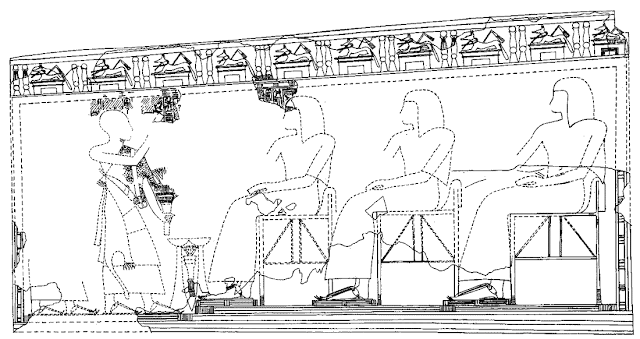
The decoration of this side began on the small section (east wall) to the left of the opening, with a harpist, who has disappeared. Most of what remains of the decoration of this wall is that of feet wearing sandals, placed on a footrest, of three people seated on open framework chairs  . There also remains of the red and yellow bands which separated the imagery from the protective dado area. There also remains part of the vertical coloured rectangular pattern which edged the wall. In front of the three seated people stand two other men, remnants of the first show that he wore the panther skin of a priest and that he held an offering in his hand. Pedestals, for offerings, are represented between the priest and the first seated guest.
. There also remains of the red and yellow bands which separated the imagery from the protective dado area. There also remains part of the vertical coloured rectangular pattern which edged the wall. In front of the three seated people stand two other men, remnants of the first show that he wore the panther skin of a priest and that he held an offering in his hand. Pedestals, for offerings, are represented between the priest and the first seated guest.
North (right) wall

On this side wall, the frieze has survived well (see vt-2953). In the scenic area only small remnants now exist. A woman's foot, standing on a mat, has survived near the middle. Near the entrance, at the top, beneath the frieze, is the remains of the top of a naos shrine. In front of this, to the left, was a tree and probably a man with his back to it, the sandaled foot still exists. According to Davies, the remains of the upper part of a shrine, carries the inscription: "[The Horus, Strong Bull], Khaemwaset, the king of Upper and Lower Egypt, Menkheperre. He made (it) for his father, Montu, given life like Re". This signifies that the naos represents the temple of Montu, of which Khonsu was the high-priest.

West wall
Note: the width of the wall to the left of the entry is approx. 0.8m, whilst to the right it is approx. 0.7m.
This was created in light relief and includes at the top, above the entrance to the next chamber, a colourful coving, the top of which projects away from the wall. It is topped with a yellow bar and has a projecting bar at the bottom, this has a white background with a yellow geometric design with some infills of dark blue. Between the two bars is the usual coving design of coloured upright bands on a white background. Between the bottom bar and the top of the entrance to the next chamber is a long band of text, also extending above the vertical side jambs. This is divided into two parts, each carrying an inscription in colourful hieroglyphs on yellow background, the text extending both right and left. The starting point is marked by a central white rectangle. Re-Horakhty and Amon are mentioned on the left, Osiris and Anubis on the right Very little remains of the left-hand side. On the right, Osiris is qualified as "Lord of the Sacred Land, lord of eternity, beneficent god of the Ennead [...]" and Anubis as "Lord of Rostaw, upon [...]". The white central area contains red and black hieroglyphs stating the name of Ra-Horakhty on the left and Osiris on the right.
Very little remains of the left-hand side. On the right, Osiris is qualified as "Lord of the Sacred Land, lord of eternity, beneficent god of the Ennead [...]" and Anubis as "Lord of Rostaw, upon [...]". The white central area contains red and black hieroglyphs stating the name of Ra-Horakhty on the left and Osiris on the right.
Each side doorpost, although having now lost most of the decoration, was decorated with a tall colourful bouquet
PASSAGEWAY TO THE ANTICHAMBER CHAMBER
the side walls have lost almost all the decoration, except, that at each inner end are traces of a seated lady facing outwards, with one or more figure images at her side.
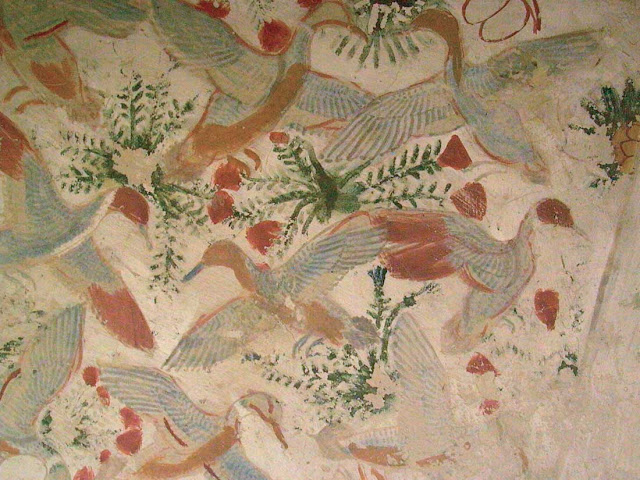 The ceiling, on the other hand, is undamaged and original for the period, because it is more an image of the 18th Dynasty (see cd-116 and cd-118). Detaching themselves from the white background are massifs of poppies and other plants. A cloud of ducks fly over their nests, in which are eggs or fledglings. Locusts can also be seen in several places. The surrounding border is plain.
The ceiling, on the other hand, is undamaged and original for the period, because it is more an image of the 18th Dynasty (see cd-116 and cd-118). Detaching themselves from the white background are massifs of poppies and other plants. A cloud of ducks fly over their nests, in which are eggs or fledglings. Locusts can also be seen in several places. The surrounding border is plain.
THE ANTICHAMBER CHAMBER
This is a small, roughly cut chamber, its wall being covered in yellow plaster, without any decoration. On the left side opens up the passageway leading to the funerary underground complex (see kampp-01). On the right side is a passageway leading to tomb TT30 of  Khonsumose, which could have been produced as a later burial installation.
Khonsumose, which could have been produced as a later burial installation.
In the far west wall is the entry of the small niche chapel (see eh-02-pm-15). The doorway of this is treated in relief, with a coving. It is surrounded, at the top and the sides, by a decorative frieze in a small checkerboard design, which curves up to the ceiling (see dm-921). The doorposts probably received columns of text. A section of the yellow collomn has survived, at the bottom of the left side, but it appears to be empty.
the bottom of the left side, but it appears to be empty.
The lintel carries a symmetrical composition (see vt-2988). On either side of an upright yellow band can be found the image of Anubis reclining on the roof of the entry of a tomb, turned towards the outside, where he faces the image of a couple who greet him. 
THE NICHE CHAPEL
This is entered by a small step and the floor is not perfectly flat. Fortunately, the decoration is preserved much better than that of the longitudinal chamber. In size it is approximately 1.0m wide by 0.7m deep and 1.4m in height. The current door frame makes the entry slightly narrower than the chamber. 
The ceiling This is divided into two sections by an uninscribed central yellow band. The design is geometric, comprised of squares containing stylistic flower designs, alternately of black on yellow with red centre and four red spots, and red on white with black centre and black spots. West facing wall
This is the only one to include a yellow, red, black and white banner at its base, above the dado area (see eh-02-pm-15). "Osiris Wennefer, the great god, master of Abydos" is seated on a cubic chair resting on a platform. This seat is elaborately decorated with the facade of a palace, with a double central door. Osiris has his dark green skin. His white shroud is overlapped at the top by necklaces, of which some have a floral design. Beneath the necklaces hangs a pendant plate bearing a djed pillar with, at either side, a red Isis knot. With his two hands, he clutches a composite sceptre comprised of the multicoloured djed pillar and a was-sceptre. On his head he has an atef-crown to which is attached a pair of twisted green horns, on either side of a solar disk, representing Re. It is about, according to the new solar theology of the Ramesside period, of showing that, in the underground world, Osiris and Re were profoundly intertwined: "Osiris rests in Re" whilst "Re rests in Osiris" as it is quoted in several tombs. Behind him, stands "Anubis, who is in his mummy wrappings, Lord of the Sacred Land", who watches over Osiris. In front of the gods stands Khonsu, draped in a magnificent panther skin, wearing white sandals. With one hand he holds a censer; with the other he pours water from an ankh-cross shaped vase and holds a bouquet of lotus flowers which fills the small remaining space.
North (right) wall

Khonsu pays homage to, Amuntet, the goddess of the west, recognisable by the hieroglyphic symbol which she wears on her head. Above Khonsu, the columns produced on a white background never received their text.
South (left) wall
This is most original, since it carries a representation of the king Montuhotep II - Nebhepetre, of the 11th Dynasty. A special article has been produced, on this site, describing royal representations in Theban tombs of the Ramesside period.
According to Davies, and as also noted in the tomb TT277 of Amenemonet, the reason for the presence of this very former sovereign was not the family interest in mortuary cults, nor the reverence for the great Theban rulers of bygone ages. The reason was that the temple of this particular monarch lay under the western cliff and contained the chapel of the cow-goddess Hathor. The king would be a metaphor indicating the west, matching that of the goddess of the west on the opposite wall. This argument may seem a little weak, because on the one hand, Montuhotep was not the only Pharaoh to be represent with Hathor coming from the mountain of the west; on the other hand, this is a typical example of a cult to a royal statue.
THE SUBTERRANEAN CHAMBERS
Of the content of these, all that is known is the laconic words of Mond: "We cleared the funerary chambers and shafts 1 and 2, but apart from twenty-two small ushabti, we didn't find anything that was worthwhile being mentioned".

This chamber is approximately 3.8m in length, 1.6m wide at the entry (east) end and 1.7m wide at the west end. The height at entry end it is approximately 1.7m and 2.0m at west end. It has a slightly upcurved ceiling.

The ceiling
In contrast with the now almost naked walls, this is preserved entirely It is slightly arched and divided into two rectangular areas by a central yellow band and also surrounded, at the edges, by two bands, one south and one north, extending to where they join the central band at the two doorways. All the bands have black texts

towards the entrance, thus the texts all start at the east end.
Text 1 (south side): "An invocatory offering to Osiris-Khentymentiu, the great god, lord of the Sacred Land; (to) Ptah-Sokar in the secret shrine; (to) Resh-Wedja in front of Rostaw (the nickname of Osiris: the awakened unscathed, Wörterbuch 2, p.451, note 13); (to) Anubis, in front of the divine pavilion; to Nefertum; (to) Horus-Hekenu, the great god on his [... ...], so that they grant the view of all secrets of the underworld, the entry and the exit of the necropolis, and that his soul be not repulsed at any of the gates of the underworld. For the Ka of the one who is greatly praised by the Lords of eternity, the high-priest of Menkheperre, Khonsu, justified, possessor of favour, happily in peace".

Text 2 (north side): "An invocatory offering to Amon-Re, king of the gods, the great god who made everything that exists, so that he may grant me to see him in the Festival of the Valley. That I may receive food in his presence, that he may cause offerings to be given to my Ka, with offerings and provisions for my mummy, that I may be summoned [...], that the hand may be bent for him (in the gesture of offering) and that myrrh and incense may be made unto him as unto all spirits, for [the Ka] of the high-priest of Menkheperre, Khonsu, justified".
Text 3 (central band): "An invocatory offering to Horakhti, the great god who lives on truth (Ma'at), that he may grant me to see him at the top of the morning, his rays turned upon my chest, that he may illuminate for me the path of darkness (night), that he may cause (my) corpse to flourish in the necropolis, [... ...] for the Ka of the high-priest of Montu, lord of Tod, To".
South (left) wall

 . There also remains of the red and yellow bands which separated the imagery from the protective dado area. There also remains part of the vertical coloured rectangular pattern which edged the wall. In front of the three seated people stand two other men, remnants of the first show that he wore the panther skin of a priest and that he held an offering in his hand. Pedestals, for offerings, are represented between the priest and the first seated guest.
. There also remains of the red and yellow bands which separated the imagery from the protective dado area. There also remains part of the vertical coloured rectangular pattern which edged the wall. In front of the three seated people stand two other men, remnants of the first show that he wore the panther skin of a priest and that he held an offering in his hand. Pedestals, for offerings, are represented between the priest and the first seated guest.North (right) wall

On this side wall, the frieze has survived well (see vt-2953). In the scenic area only small remnants now exist. A woman's foot, standing on a mat, has survived near the middle. Near the entrance, at the top, beneath the frieze, is the remains of the top of a naos shrine. In front of this, to the left, was a tree and probably a man with his back to it, the sandaled foot still exists. According to Davies, the remains of the upper part of a shrine, carries the inscription: "[The Horus, Strong Bull], Khaemwaset, the king of Upper and Lower Egypt, Menkheperre. He made (it) for his father, Montu, given life like Re". This signifies that the naos represents the temple of Montu, of which Khonsu was the high-priest.

West wall
Note: the width of the wall to the left of the entry is approx. 0.8m, whilst to the right it is approx. 0.7m.
This was created in light relief and includes at the top, above the entrance to the next chamber, a colourful coving, the top of which projects away from the wall. It is topped with a yellow bar and has a projecting bar at the bottom, this has a white background with a yellow geometric design with some infills of dark blue. Between the two bars is the usual coving design of coloured upright bands on a white background. Between the bottom bar and the top of the entrance to the next chamber is a long band of text, also extending above the vertical side jambs. This is divided into two parts, each carrying an inscription in colourful hieroglyphs on yellow background, the text extending both right and left. The starting point is marked by a central white rectangle. Re-Horakhty and Amon are mentioned on the left, Osiris and Anubis on the right
 Very little remains of the left-hand side. On the right, Osiris is qualified as "Lord of the Sacred Land, lord of eternity, beneficent god of the Ennead [...]" and Anubis as "Lord of Rostaw, upon [...]". The white central area contains red and black hieroglyphs stating the name of Ra-Horakhty on the left and Osiris on the right.
Very little remains of the left-hand side. On the right, Osiris is qualified as "Lord of the Sacred Land, lord of eternity, beneficent god of the Ennead [...]" and Anubis as "Lord of Rostaw, upon [...]". The white central area contains red and black hieroglyphs stating the name of Ra-Horakhty on the left and Osiris on the right.Each side doorpost, although having now lost most of the decoration, was decorated with a tall colourful bouquet
 The ceiling, on the other hand, is undamaged and original for the period, because it is more an image of the 18th Dynasty (see cd-116 and cd-118). Detaching themselves from the white background are massifs of poppies and other plants. A cloud of ducks fly over their nests, in which are eggs or fledglings. Locusts can also be seen in several places. The surrounding border is plain.
The ceiling, on the other hand, is undamaged and original for the period, because it is more an image of the 18th Dynasty (see cd-116 and cd-118). Detaching themselves from the white background are massifs of poppies and other plants. A cloud of ducks fly over their nests, in which are eggs or fledglings. Locusts can also be seen in several places. The surrounding border is plain.THE ANTICHAMBER CHAMBER
 Khonsumose, which could have been produced as a later burial installation.
Khonsumose, which could have been produced as a later burial installation.In the far west wall is the entry of the small niche chapel (see eh-02-pm-15). The doorway of this is treated in relief, with a coving. It is surrounded, at the top and the sides, by a decorative frieze in a small checkerboard design, which curves up to the ceiling (see dm-921). The doorposts probably received columns of text. A section of the yellow collomn has survived, at
 the bottom of the left side, but it appears to be empty.
the bottom of the left side, but it appears to be empty.The lintel carries a symmetrical composition (see vt-2988). On either side of an upright yellow band can be found the image of Anubis reclining on the roof of the entry of a tomb, turned towards the outside, where he faces the image of a couple who greet him.

This is entered by a small step and the floor is not perfectly flat. Fortunately, the decoration is preserved much better than that of the longitudinal chamber. In size it is approximately 1.0m wide by 0.7m deep and 1.4m in height. The current door frame makes the entry slightly narrower than the chamber.

North (right) wall

Khonsu pays homage to, Amuntet, the goddess of the west, recognisable by the hieroglyphic symbol which she wears on her head. Above Khonsu, the columns produced on a white background never received their text.
South (left) wall
According to Davies, and as also noted in the tomb TT277 of Amenemonet, the reason for the presence of this very former sovereign was not the family interest in mortuary cults, nor the reverence for the great Theban rulers of bygone ages. The reason was that the temple of this particular monarch lay under the western cliff and contained the chapel of the cow-goddess Hathor. The king would be a metaphor indicating the west, matching that of the goddess of the west on the opposite wall. This argument may seem a little weak, because on the one hand, Montuhotep was not the only Pharaoh to be represent with Hathor coming from the mountain of the west; on the other hand, this is a typical example of a cult to a royal statue.
 |
Of the content of these, all that is known is the laconic words of Mond: "We cleared the funerary chambers and shafts 1 and 2, but apart from twenty-two small ushabti, we didn't find anything that was worthwhile being mentioned".

















